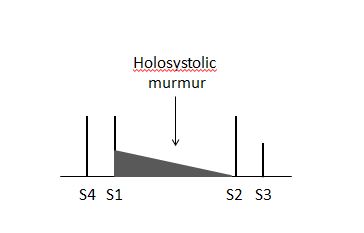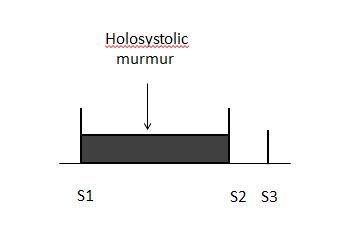Mitral regurgitation resident survival guide
Editor-In-Chief: C. Michael Gibson, M.S., M.D. [1]; Associate Editor(s)-in-Chief: Raviteja Guddeti, M.B.B.S. [2]; Mugilan Poongkunran M.B.B.S [3]
| Pericarditis Resident Survival Guide Microchapters |
|---|
| Overview |
| Causes |
| FIRE |
| Complete Diagnostic Approach |
| Treatment |
| Do's |
| Don'ts |
Overview
Mitral regurgitation (MR), mitral insufficiency or mitral incompetence refers to a disorder of the heart in which the mitral valve fails to close properly during systole. This leads to leakage of blood flow from left ventricle to left atrium during systole and reduction in cardiac output. The symptoms associated with mitral regurgitation are dependent on which phase of the disease process the individual is in. Individuals with acute mitral regurgitation are often gravely ill with significant hemodynamic abnormalities due to decompensated congestive heart failure and low cardiac output that require urgent treatment, whereas individuals with chronic compensated mitral regurgitation may be asymptomatic, with a normal exercise tolerance and no evidence of heart failure.[1] The management of chronic MR depends on whether the condition is chronic primary MR (the mitral valve is usually abnormal) or chronic secondary MR (the mitral valve is usually normal) and the severity of the valve anatomy.[2]
Causes
Life Threatening Causes
Life-threatening causes include conditions which may result in death or permanent disability within 24 hours if left untreated.
Common Causes
Acute Mitral Regurgitation
- Papillary muscle rupture: Acute myocardial infarction, chest trauma, ischemia
- Ruptured mitral chordae tendinae: Acute rheumatic fever, chest trauma, mitral valve prolapse, infective endocarditis, spontaneous rupture[3][4][5]
Chronic Primary Mitral Regurgitation
Chronic Secondary Mitral Regurgitation
Click here for the complete list of causes.
FIRE: Focused Initial Rapid Evaluation
A Focused Initial Rapid Evaluation (FIRE) should be performed to identify patients in need of immediate intervention.
Boxes in red signify that an urgent management is needed
Complete Diagnostic Approach to Mitral Regurgitation
Shown below is an algorithm summarizing the complete diagnostic approach to mitral regurgitation according to 2014 AHA/ACC guidelines for management of valvular heart disease.[2].
AF: Atrial fibrillation; MR: Mitral regurgitation; EKG: Electrocardiogram; S1: First heart sound; S2: Second hert sound; S3; Third heart sound; LV: Left ventricle; MVP: Mitral valve prolapse
Characterize the symptoms: Acute mitral regurgitation: ❑ Symptoms of shock and pulmonary edema:
❑ Symptoms suggestive of precipitating events:
Chronic mitral regurgitation:
❑ Symptoms associated with decreased forward flow and increased backflow across mitral valve:
❑ Symptoms associated with complications:
❑Other etiology associated symptoms:
| |||||||||||||||||||||||||||||||||||||||||||||||||||||||||||||||||||
Obtain a detailed history: ❑ Past medical history:
❑ Family history: ❑ Medications: | |||||||||||||||||||||||||||||||||||||||||||||||||||||||||||||||||||
Examine the patient: Vital signs:
Skin: Cardiovascular system:
❑ Thrill (in acute MR and severe chronic MR) ❑ Elevated jugular venous pulse
Auscultation:
❑ Murmur
Respiratory system: Abdominal system: Neurological system: | |||||||||||||||||||||||||||||||||||||||||||||||||||||||||||||||||||
Order electrocardiogram (Urgent):
❑ Mostly normal in acute MR
Order chest X-ray (urgent): ❑ Acute MR
Order transthoracic echocardiography (TTE) (urgent): ❑ Confirmatory Order lab tests: ❑ CBC Other tests ❑ Transesophageal echocardiography (TEE if TTE is equivocal)
❑ Exercise testing
| |||||||||||||||||||||||||||||||||||||||||||||||||||||||||||||||||||
Cardinal findings that are suggestive of acute mitral regurgitation ❑ Sudden onset and rapid progression of pulmonary edema
| Cardinal findings that are suggestive of chronic mitral regurgitation ❑ Asymptomatic to chronic symptoms
| ||||||||||||||||||||||||||||||||||||||||||||||||||||||||||||||||||
| Mitral valve anatomy | |||||||||||||||||||||||||||||||||||||||||||||||||||||||||||||||||||
| Normal | Abnormal | ||||||||||||||||||||||||||||||||||||||||||||||||||||||||||||||||||
| Chronic primary mitral regurgitation | Chronic secondary mitral regurgitation | ||||||||||||||||||||||||||||||||||||||||||||||||||||||||||||||||||
Treatment
Treatment of Acute Mitral Regurgitation
Shown below is an algorithm summarizing the approach to the management of acute severe mitral regurgitation according to 2014 AHA/ACC guidelines for management of valvular heart disease.[2].
MR: Mitral regurgitation; IE: Infective endocarditis
❑ Establish the diagnosis of acute MR | |||||||||||||||||||||||||||||||||||||||||||||||||||||||||||||||||||
❑ Assess if the patient is hemodynamically stable? | |||||||||||||||||||||||||||||||||||||||||||||||||||||||||||||||||||
| Unstable | Stable | ||||||||||||||||||||||||||||||||||||||||||||||||||||||||||||||||||
❑ Stabilize the patient
| |||||||||||||||||||||||||||||||||||||||||||||||||||||||||||||||||||
Refer for surgical repair:
| ❑ Refer for surgical repair in:
| ||||||||||||||||||||||||||||||||||||||||||||||||||||||||||||||||||
Treatment of Chronic Mitral Regurgitation
Diagnosis
Symptoms
- Acute mitral regurgitation causes the following symptoms:
- Chronic mitral regurgitation may have a prolonged asymptomatic interval phase until the heart decompensates and the symptoms of low cardiac output and pulmonary congestion start. By the time the symptoms develop, left ventricular dysfunction may have already occurred.
Physical Examination
- S3 and S4 may be heard on auscultation.
- A holosystolic murmur is heard in the apical region of the heart. MR murmur radiates to the axillary region. It may be soft, short and even absent. 70% of the cases of papillary muscle rupture have no murmur.
 |
 |
Imaging
Transthoracic echocardiography
Echocardiographic findings indicating the presence of severe mitral regurgitation include:
- Regurgitant volume >60 ml
- Regurgitant fraction >55%
- Effective regurgitant orifice (ERO) (ratio of regurgitant flow volume to the velocity of the mitral insufficiency jet: ERO = Flow / Velocity) >0.4 cm2
- If the left ventricular and left atrial sizes are normal on echocardiography, mitral regurgitation is not severe.
- Central jets indicate the presence of a fairly normal mitral valve and therefore the mitral regurgitation is not severe.
- Wide eccentric jets indicate that the regurgitation is severe.
- Echocardiographic findings must match the symptoms, if they do not, perform transesophageal echocardiography (TEE) or cardiac catheterization. TTE can underestimate the magnitude of mitral regurgitation in patients with clinical signs of severe MR.
Treatment
Acute Severe Mitral Regurgitation
- Treatment of acute severe mitral regurgitation depends on the stability of the patient.If the patient is clinically stable, the treatment options are:
- IV vasodilators, diuretics, antibiotics, anti-ischemic agents
- Surgery is preferred in the following cases:
- Endocarditis with progressive congestive heart failure
- No response to antibiotics
- Abscess formation
- Recurrent embolization
- If the patient is clinically unstable , the treatment options are:
- IV nitroprusside is used to maintain blood pressure. Inotropes are added when needed.
- If medical therapy is not effective, an intra aortic balloon pump can be inserted to maintain hemodynamic stability.
- Surgical treatment is usually indicated.
- Knowledge of the etiology of the mitral regurgitation is important to know if the valve can be repaired or replaced.
Chronic Mitral Regurgitation
Why the Mitral valve is replaced Before Symptoms in Patients with Chronic Mitral Regurgitation
- Mitral regurgitation is a syndrome of pure volume overload whereas aortic regurgitation is a combination of both volume and pressure overload.
- Both syndromes are associated with an increase in preload.
- in mitral regurgitation, the afterload is reduced whereas in aortic regurgitation the afterload is increased. This is very important because when the mitral valve is repaired, there is no longer a reduction afterload and the left ventricle may fail due to an abrupt rise in the afterload. In aortic regurgitation, because the afterload is already increased chronically, replacement of the valve is not as likely to precipitate acute left ventricular failure due to an abrupt rise in afterload.
- By the time symptoms develop, there is already left ventricular dysfunction.
- Because of the low pressure system into which the blood is ejected into through the mitral valve, the ejection fraction is always high in mitral regurgitation. If the ejection fraction appears to be "normal", there is already decline in left ventricular function.
- There is no indication for vasodilator therapy in the absence of systemic hypertension in asymptomatic patients with preserved left ventricular function.
Indications for Surgery in Chronic Mitral Regurgitation
The indications for surgery in chronic mitral regurgitation are:
- Any symptoms - this is unlike mitral stenosis where surgeons operate on the heart when patients have class III or IV symptoms.
- Severe organic MR.
- Left ventricular dysfunction - ejection fraction <60% and end systolic diameter >40 mm2.
- Surgery can be considered in asymptomatic patients in the following cases:
- Truly severe MR
- Low operative mortality
- High chance of successful repair (e.g: posterior leaflet - MVP)
- Pre-operative ejection fraction has a prognostic impact in patients who undergo mitral valve repair or replacement. The lower the ejection fraction is, the higher the mortality is.
Do's
Don'ts
- Don't perform coronary angiography before valve surgery in patients who are hemodynamically unstable.
- Avoid coronary angiography in patients of acute coronary syndrome complicated by severe acute mitral regurgitation.
References
- ↑ Stout KK, Verrier ED (2009). "Acute valvular regurgitation". Circulation. 119 (25): 3232–41. doi:10.1161/CIRCULATIONAHA.108.782292. PMID 19564568.
- ↑ 2.0 2.1 2.2 2.3 Nishimura RA, Otto CM, Bonow RO, Carabello BA, Erwin JP, Guyton RA; et al. (2014). "2014 AHA/ACC Guideline for the Management of Patients With Valvular Heart Disease: Executive Summary: A Report of the American College of Cardiology/American Heart Association Task Force on Practice Guidelines". Circulation. doi:10.1161/CIR.0000000000000029. PMID 24589852.
- ↑ Grenadier E, Alpan G, Keidar S, Palant A (1983). "The prevalence of ruptured chordae tendineae in the mitral valve prolapse syndrome". Am Heart J. 105 (4): 603–10. PMID 6837414.
- ↑ Grinberg AR, Finkielman JD, Piñeiro D, Festa H, Cazenave C (1998). "Rupture of mitral chorda tendinea following blunt chest trauma". Clin Cardiol. 21 (4): 300–1. PMID 9580528.
- ↑ Anderson Y, Wilson N, Nicholson R, Finucane K (2008). "Fulminant mitral regurgitation due to ruptured chordae tendinae in acute rheumatic fever". J Paediatr Child Health. 44 (3): 134–7. doi:10.1111/j.1440-1754.2007.01214.x. PMID 17854408.
- ↑ Otto CM (2001). "Clinical practice. Evaluation and management of chronic mitral regurgitation". N Engl J Med. 345 (10): 740–6. doi:10.1056/NEJMcp003331. PMID 11547744.